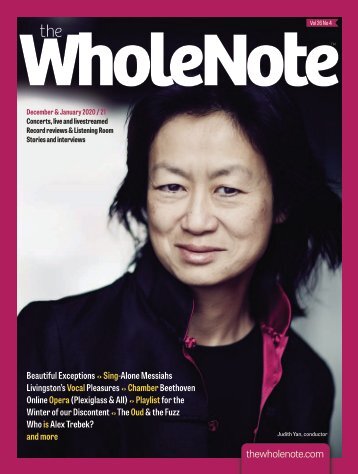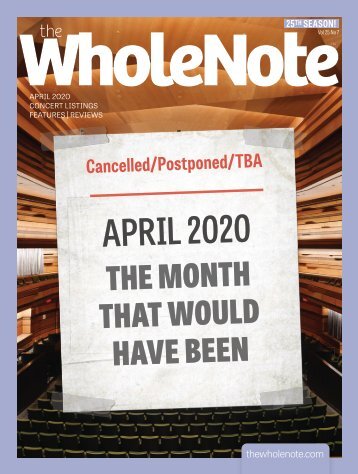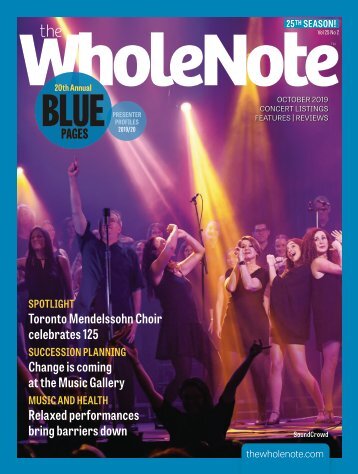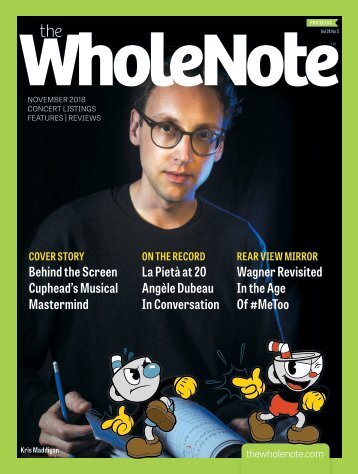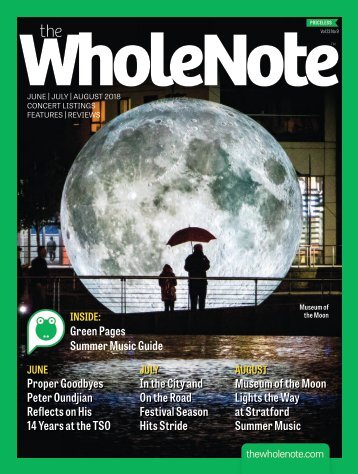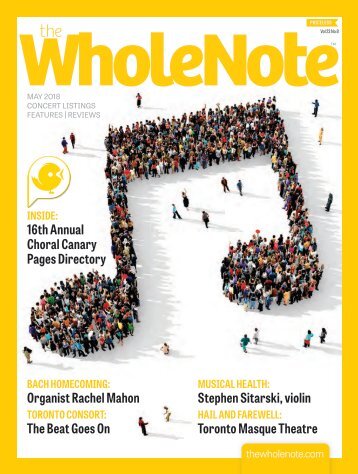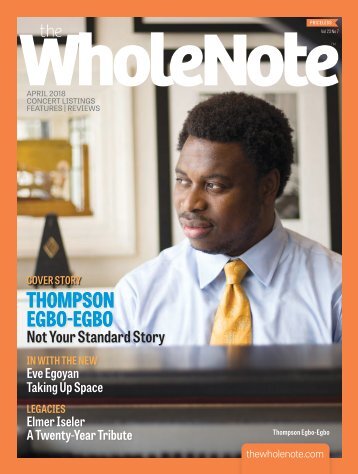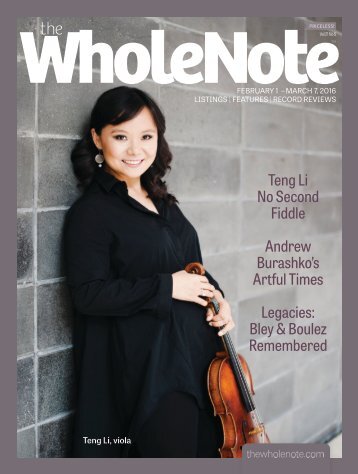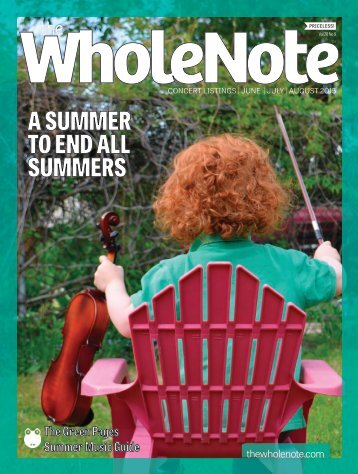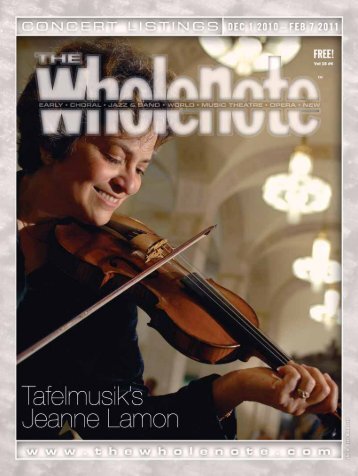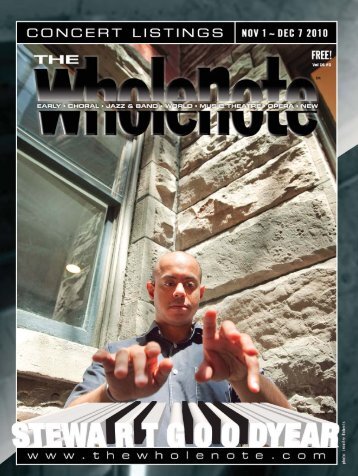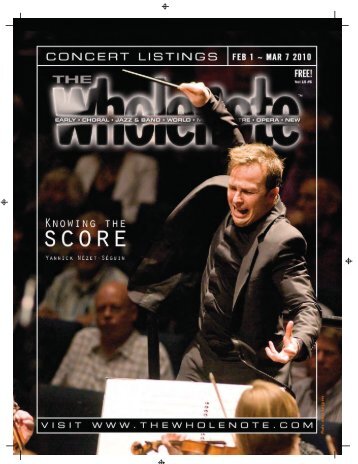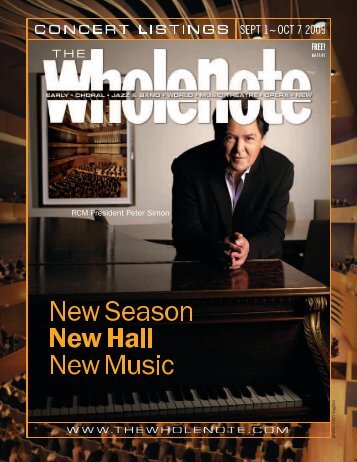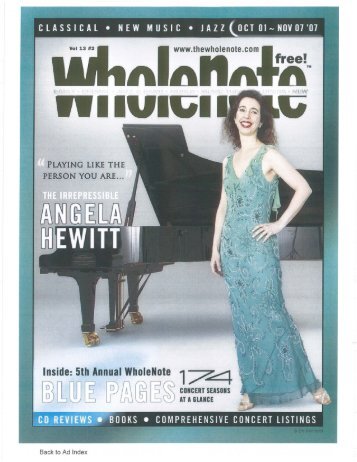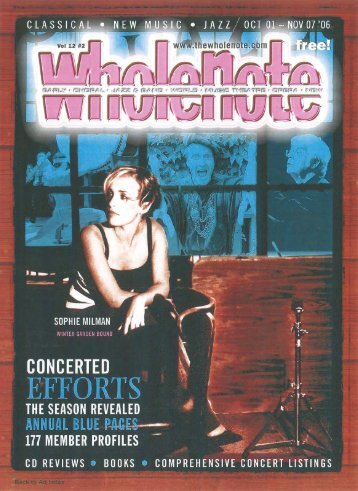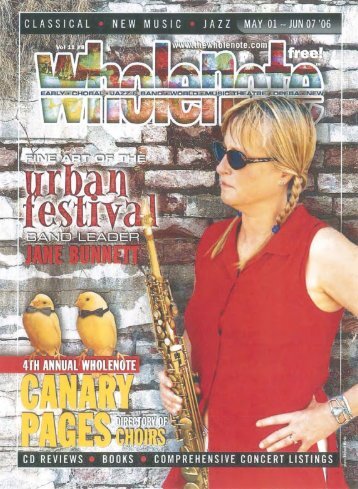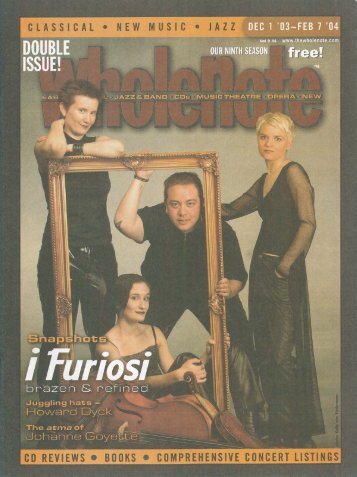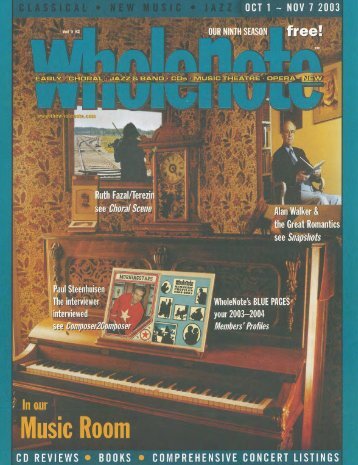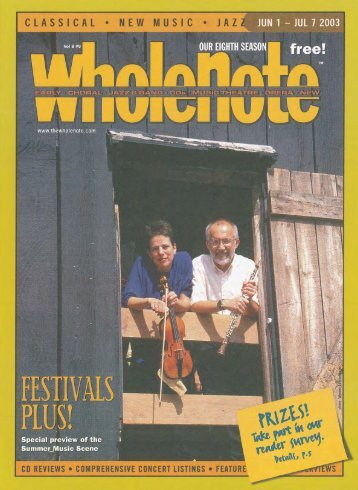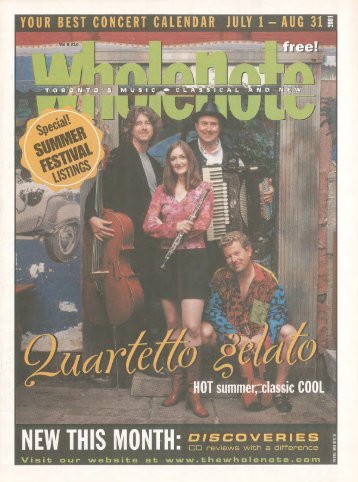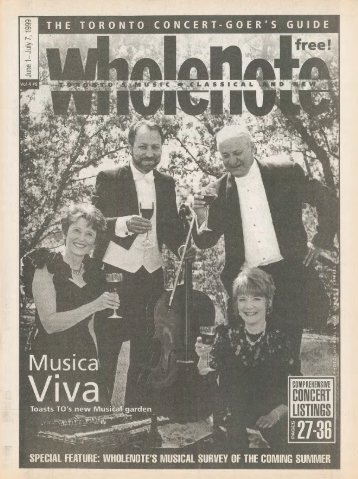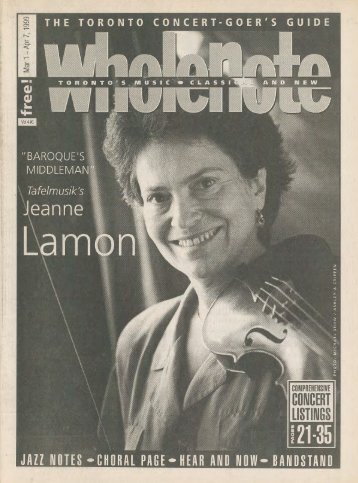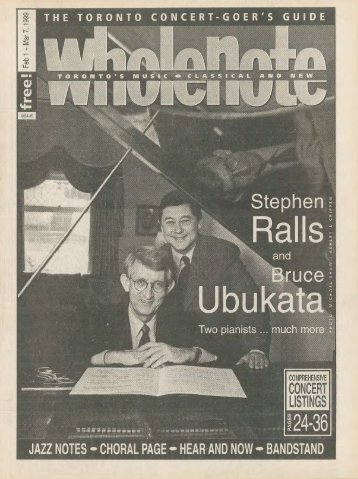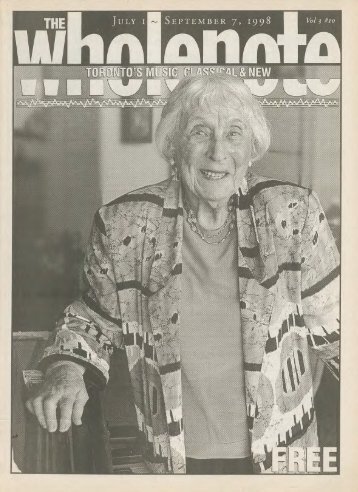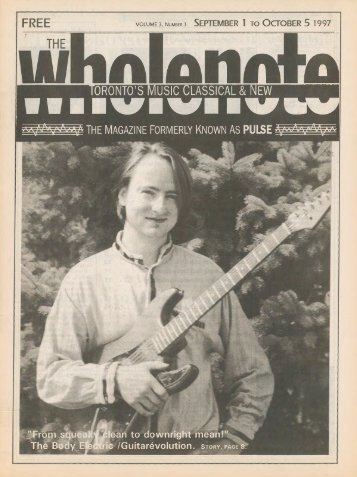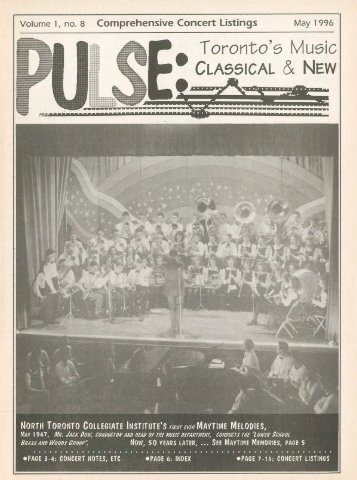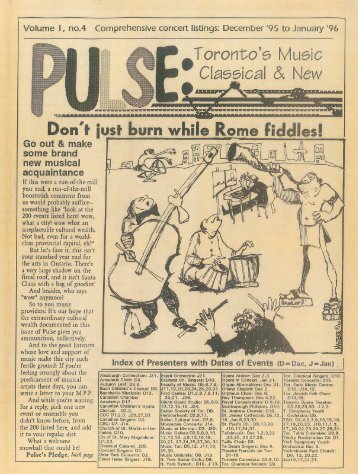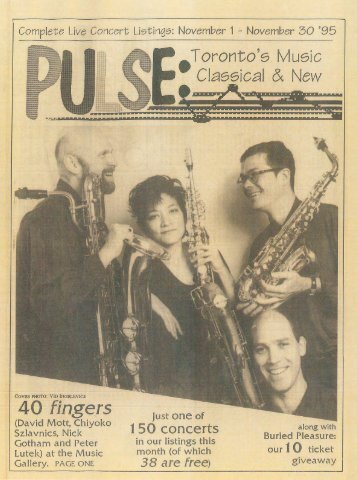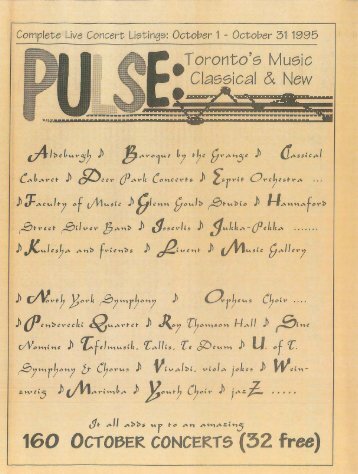Volume 26 Issue 5 - February 2021
- Text
- Toronto
- Recordings
- Musicians
- Pianist
- Composer
- Quartet
- Musical
- Jazz
- Recording
- February
So, How Much Ground WOULD a ground hog hog? community arts and the Dominion Foundries end run; the vagaries of the concert hall livestreaming ban; hymns to freedom; postsecondary auditions do the COVID shuffle; and reflections on some of the ways the music somehow keeps on being made - PLUS 81 (count them!) recordings we've been listening to. Also a page 2 ask of you. Available in flipthrough format here and in print February 10.
Jazz Notes New Year Same
Jazz Notes New Year Same Old IRENE MILLER A warm and lively INNERchamber event, pre-pandemic The concert planned for February 7, titled Lost and Found, features the music of Pamela Jane Gerrand, singer and narrator, (pamelajanegerrand.com), based on her own poetry as well as the poetry of Rumi. It will also include a performance of Tōru Takemitsu’s Toward the Sea, originally commissioned in 1981 by Greenpeace for the Save the Whales campaign. Gerard Yun, shakuhachi, Daniel Ramjattan, guitar, and percussionist Graham Hargrove, will join Chung, Bolt-Martin and Gerrand. In conversation with me, Gerrand described the concert as “an ode to this time of year that seems endless. It’s a time when we go within to find inspiration, strength and resilience.” The various pieces on the program have been chosen to help us “find solace and the experience of being found” (something I’m sure many of us can relate to right now). “We’ve lost our access points in this time of sequestering,” Gerrand says. Gerrand’s journey as a performing artist began in theatre, gradually shifting over to songwriting when she began creating works to express the universal experience of being human – “the beauty and the pain, the connection and brokenness ... At this time, we’re all suffering from the disease of disconnection, and the warmth that comes when we sing from the heart is where we can make the ineffable known. We can blast away the illusion of separation and come into the field of love.” She remains hopeful and determined. “During this time of forced separation, people are learning how to go within,” she said, “and connect to their emotions and vulnerabilities; and, in that process, many are finding the gift of their own creativity.” At the time I spoke with Gerrand, towards the end of January, the plan was for the concert to be livestreamed, from Revival House in Stratford, INNERchamber’s usual restaurant partner, with each of the players sufficiently distanced from each other and with the livestream captured by eight cameras. Since then the concert, like its title, has been “lost and found.” Given that the only places performers can currently perform from are TV or recording studios, it will be streamed instead from Canterbury Music Company studios in Toronto, but with Stratford-based audiences able to pick up concert day takeout meals from Revival House as usual, and tune in from there the way I was planning to tune in from here. Wendalyn Bartley is a Toronto-based composer and electrovocal sound artist. sounddreaming@gmail.com. STEVE WALLACE Many would agree that 2020 was the worst we’ve ever been through and we were all anxious to see the end of “The Year of Living Covidously.” So good riddance, 2020, and don’t let the door hit your ass on the way out. But of course the root of all our problems and suffering – the pandemic – hasn’t gone anywhere and simply flipping over to January of a new year on the calendar hasn’t solved it, any more than anything else we’ve tried. And Lord knows we’ve tried lots, at least most of us. Masking up, staying at home, social distancing, keeping our bubbles small, working from home (that’s if you still have a job), forgetting what eating in a restaurant or hearing live music feel like. Stores and schools closed, then open, then sort of half-open, then not. And still the numbers go up as we chase this invisible enemy, to the point where The Myth of Sisyphus no longer seems a metaphor but something we’re living on a daily basis. Keep pushing that boulder. None of this is to say that we should join the ranks of the antimask loonies or herd-immunity-at-any-cost-COVID-deniers, not at all. We have only to look south of the border to see how well that hasn’t worked, as Samuel Goldwyn might have put it. Clearly we must stay the course with these mitigation measures because they’re the best tools we have and, just as clearly, we would be even worse off without abiding them in the last year. It’s just that after nine months and counting of cave-dwelling isolation… well, it’s getting harder. To quote one of Mose Allison’s more sardonic later songs – “I am not discouraged. I am not downhearted. I am not disillusioned… But I’m gettin’ there… yeah, I’m Mose Allison gettin’ there.” And You Thought Jazz was Confusing As someone who has spent an awful lot of time over the past 30 years being out of the house maintaining an insanely gruelling work regimen – full-time days at a law library, a busy playing schedule, with writing and teaching thrown in more recently – I haven’t found this much staying at home all that hard. I suspect I speak for many when I say that what I have found hard is the disorienting brain-fog which has resulted from so many months of anxious uncertainty about how we’re supposed to find a way out of this mess and how long that will take. Part of it has to do with the nature of the virus itself and how it behaves, which is proving elusive even to epidemiologists. I believe in following the science and am inclined to cut our leaders, both political and medical, some slack because none of this came with a road map, but often a lack of consistent messaging and MOSE ALLISON 22 | February 2021 thewholenote.com
BRIAN MCMILLEN Frank Kimbrough A couple of days ago I was practising the bass – for what, I couldn’t tell you – when I began playing a blues in F. And sure enough, just like always, the structure was 12 bars long. transparency from them have made things worse. Sometimes it seems like they’re making it up as they go along. Then there’s the mounting socio-economic and psychological fallout from all of this, hence the Twilight Zone fog we’re stumbling around in, as if somebody opened up a great big can of WEIRD. The horrific and (almost) shocking events of January 6 only served to ratchet up the insanity of everything a few notches. A couple of days later while swimming upstream in this mucky soup, I began laughing out loud while drooling slightly as a strange thought hit me: compared to all of this, jazz seems normal, a veritable oasis of reason, order and sanity. How often do you hear that? Throughout its history, except for a couple of decades in and around the 30s through the 40s when it was popular music, jazz has suffered from a reputation of being confusing, flighty, inaccessible, too complex and abstract to be really enjoyable. Its practitioners were seen as low-life bohemians, drunks and drug addicts who wore strange clothes and affected insider hipster dialogue. Like weirdsville – dig, baby. And all this was before jazz discovered atonality. Like the coronavirus itself, jazz cannot be seen or touched. Really it can only be heard and felt, but at least it won’t make you sick or kill you – at least not most of the time. But it’s only taken life during a little old pandemic to make jazz seem solid, almost intelligible. For example, a couple of days ago I was practising the bass – for what, I couldn’t tell you – when I began playing a blues in F. And sure enough, just like always, the structure was 12 bars long and no matter how many different chord-change variations I played, it always went to a B-flat 7 in bar five. And the particular minor-major dichotomy of that chord change had the same thrilling and mysterious rub as ever. It’s nice to know you can count on something these days. It’s the same with jazz records. For the umpteenth time the other day I listened to “Shoe Shine Boy” from the immortal 1936 Jones- Smith Incorporated session which marked Lester Young’s recording debut. And it knocked me out just as much as always – the darting velocity and swing of it, Young’s swooping two-chorus masterpiece solo as brilliant and daringly inventive as ever. Ineffable, yet carved in stone. Then over to Kind of Blue, and sure enough, Jimmy Cobb’s cosmic ride-cymbal splash just ahead of Miles Davis’ solo entry on “So What” – still for me the most magic moment of many on that magical record – was still there in all its glory. It’s not that I expected these and other gleaming gems to have changed – after all, once music is recorded, it’s fixed in place forever and I know that. But these days, you find yourself wondering. Jazz is neither weird nor confusing. Like everything else, it only seems so if you don’t understand it, or at least try. But life with COVID is decidedly weird and confusing. The only saving grace is that like wars, pandemics eventually end, whereas jazz is forever. Thank goodness. Sound the Knell Again As I mentioned in a previous column, 2020 was a horrible year for jazz musicians dying and unfortunately this parade has continued through early January. New York pianist Frank Kimbrough died of a sudden heart attack on December 31 at the age of 64. A very creative improviser/composer and a revered teacher, Kimbrough was known for his long association with the Maria Schneider Orchestra, for founding the Herbie Nichols Project with bassist Ben Allison, a longtime collaborator, and for being a charter member of the Jazz Composers’ Collective. His last recording was the ambitious 6-CD 2018 release, Monk’s Dreams: The Complete Compositions of Thelonious Sphere Monk, with multi-reedman Scott Robinson, bassist Rufus Reid and drummer Billy Drummond. Kimbrough died far too young and his death will leave a big hole. Composer/arranger Sammy Nestico, best-known for his prolific writing for Count Basie, died on January 17 at 96. At least he made it to a ripe old age and if I had a dollar for every time I played one of his Enjoy live music from home! ONLINE EDITION Season 10 is here! Join us every month for live jazz performances! For schedule and tickets: niagarajazzfestival.com Enjoy the show, or dinner & the show with our restaurant partners Or call us at: 1-844-LIV-JAZZ (548-5299) thewholenote.com February 2021 | 23
- Page 1 and 2: Volume 26 No 5 FEBRUARY 5 TO MARCH
- Page 3 and 4: 2605_Feb_cover.indd 1 2021-02-03 6:
- Page 5 and 6: FOR OPENERS | DAVID PERLMAN Groundh
- Page 7 and 8: 153 Eastern Avenue: The destruction
- Page 9 and 10: If music is an essential aspect of
- Page 11 and 12: VIRTUAL CONCERT SERIES Thur. Februa
- Page 13 and 14: Singing the Way to Freedom JACK BUE
- Page 15 and 16: First up is Veda Hille and Amiel Gl
- Page 17 and 18: On My Mind The Rocking Horse Winner
- Page 19 and 20: JIYANG CHEN Arlen Hlusko life” mo
- Page 21: French/Argentine composer Martin Ma
- Page 25 and 26: The last thing [schools wanted] was
- Page 27 and 28: JOAN ANDREWS Jack with his trombone
- Page 29 and 30: PLEASE NOTE: All times are Eastern
- Page 31 and 32: Classified Advertising | classad@th
- Page 33 and 34: Quartet No.2 “Lost Prayers,” pe
- Page 35 and 36: spirit to the Bach partitas than th
- Page 37 and 38: Vivaldi - Luce e Ombra Myriam Lebla
- Page 39 and 40: Jaromír Weinberger - Frühlingsst
- Page 41 and 42: Schubert: The Power of Fate Mathieu
- Page 43 and 44: on several instruments and studied
- Page 45 and 46: longer mourn for me falls into this
- Page 47 and 48: Howells and Bruce Cassidy on trumpe
- Page 49 and 50: electric guitar, Chad Coe on acoust
- Page 51 and 52: pieces by J.S. Bach, Duane Allman a
- Page 53 and 54: Other Fine Vintages James Campbell,
- Page 55 and 56: Vol 25 No 9 PRICELESS Vol 26 No 1 P
Inappropriate
Loading...
Mail this publication
Loading...
Embed
Loading...
























